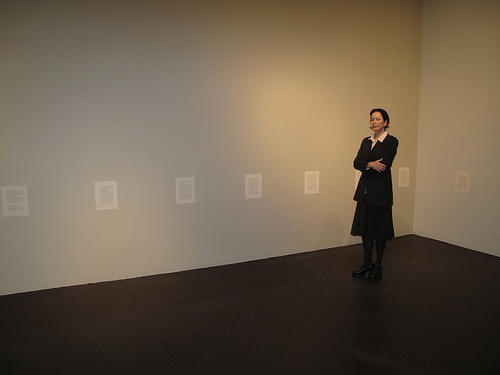Vanessa Place Talks Texts as Presentational, New Projects at BOMBLOG

Over at BOMBLOG is a Q&A with Vanessa Place and Andrea Quaid, "on the simultaneity, reflection, and transformation of conceptualism." First, Quaid updates us on Place's current projects:
Newly published by P-queue Editions, The Father & Childhood is a selection from a second serial work, Boycott Project, with the eagerly awaited complete work, Boycott Project, forthcoming this year from Ugly Duckling Presse. In this work, Place collects canonical feminist texts and replaces all feminine pronouns and gendered terms with their masculine counterpart to create a textual encounter leveled into masculine sameness. It’s all about men. As co-director of Les Figues Press and as editor, with Caroline Bergvall, Laynie Brown, and Teresa Carmody, Place collaborated on the recently completed anthology, I’ll Drown My Book: Conceptual Writing By Women.
They talk about the relationship between creative writing and theoretical work as conceived by Place. The question: "How do you experience the relationship between the two types of writing?" And the answer: "They are the same thing, just different performances." More from the conversation:
AQ Conceptual writing, which often uses and re-purposes already existent text, constructing rather than composing, appears to enter a conversation predicated on categories of the copy and the simulacrum. And yet, it seems that conceptual writing’s appropriations work otherwise?
VP Because there is no copy or simulacrum, simply simultaneity. Not of events, which presupposes temporality, or, as George Eliot might say, beginnings, middles, and ends, but of points, which are also spatial. Points of caption, as it were. Postmodernism was very concerned with a managed chaos, disorder put to right ends. Conceptualism is disinterested in ends, except as terminal. The stuff of conceptualism, the textual thing, is the most static of objects, inert, inutile. Dead as a doorknob. Its representations are radical mimesis because they do not represent, just present. Yesterday’s news, the tiny tragedies of today.
AQ Current theoretical work seeking to address postmodernism’s perceived impasses focuses a new or renewed attention to questions of affect, embodiment and materiality. Much of this work tries to understand what is different about our contemporary now by engaging categories that postmodern analytics overlooks or casts aside. How are these discrete but associated discourses at work in conceptual writing?
VP One begins with a definition of conceptualism as writing which does not direct its reception. This shifts the locus of the work to its recipient, necessarily embodied, necessarily affected. What is boredom, after all, if not maximal minimal affect? The question of materiality is closer here to a medieval notion of materialism in which the highest form of materiality is that which is transformed by nothing but the divino spiritu—such as the Eucharist. These categories are no longer so discrete as each becomes not inherent in the stuff, but one of its categorical imperatives.
Quaid and Place also discuss that little word "sobject."
AQ The sobject, or I of conceptualism, seems definitively distinctive from modernism’s resolutely resistant, autonomous individual and postmodernism’s always-already constructed container of the social. As you have said, “I am because and as my Facebook friends know me.” One issue conceptual writing engages, and which your claims about our conceptualist period point to, is that one now imagines, understands, and lives its I differently.
VP The I is a performance of an I, the I the I is.
AQ Conceptual writing as critique, which is how I think about your work in particular, is often a direct encounter with (and counter to) master narratives and discourses in a manner unlike postmodernism’s proliferating others as resistance to a totalizing unity. I am thinking here of the move from the postmodern fragment to conceptualism’s appropriated wholes. Is it fair to say the difference is one of position?
VP A mirror is always a point of position and opposition—though if there is a countering in conceptualism, it lies in the encounter with oneself. Master narratives, after all, are neither alien nor free-floating. Thus, one cannot say that race, gender, etc, are constructs without adding, “that I construct.” There is a temptation to substitute the first person plural for the singular in that sentence, but this is the fallacy (and comfort) of the accomplice to the crime. A mirror only works insofar as I recognize or refuse to recognize myself reflected in it—like poetry, it answers the question “what does this say about me?”
Read the entire interview here.


